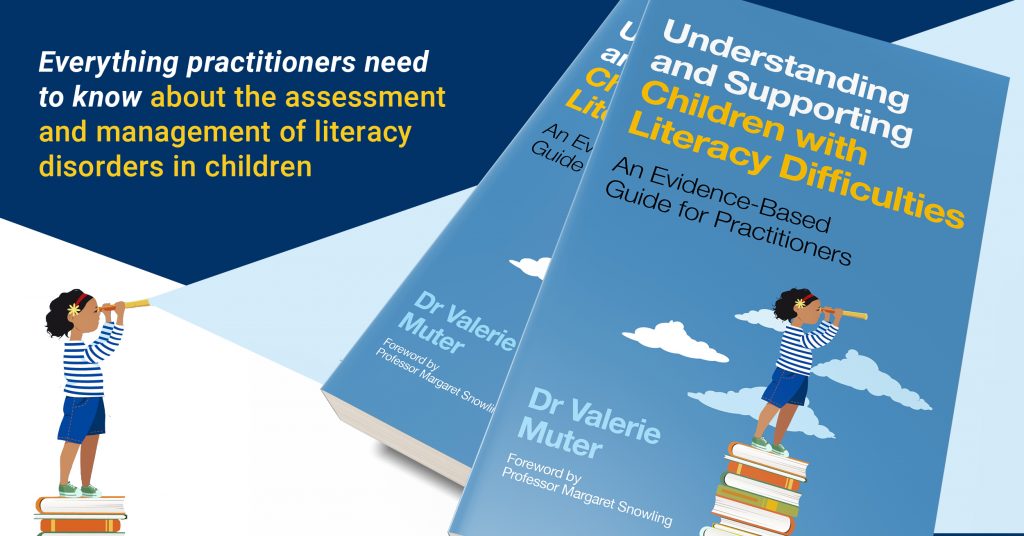
Dr Valerie Muter is a clinical and research psychologist with a special interest in children’s early cognitive development, particularly in relation to language and literacy. She is also the author of Understanding and Supporting Children with Literacy Difficulties.
The use of the term dyslexia to describe children who have difficulty learning to read is one that has for many years generated a great deal of controversy. Is it a label employed by ambitious middle-class parents who are disappointed by their child’s failure to be as academic as they’d hoped, or is it a genuine learning difficulty that warrants due recognition and specialist teaching?
One of the criticisms that has been directed repeatedly at the use of the term dyslexia is that it carries the assumption that an inherent cognitive deficit results in the child struggling to learn to read – specifically, a weakness in phonological (speech sound) processing that makes it hard for the child to learn to phonically decode words and so read and spell accurately. However, as Elliott and Grigorenko argue in their book The Dyslexia Debate (2014), it is not possible at the current time to separate poor readers into clear causal groups, based upon either biological or cognitive phenomena. Nor they continue can we identify a biologically- or cognitively (presumably phonologically) – based dyslexic subgroup within a larger pool of poor readers. Elliott and Grigorenko also claim that there is an erroneous belief that a diagnosis of dyslexia can result in appropriately tailored forms of intervention that address the child’s underlying deficit and which will therefore improve their reading capabilities. The authors conclude by calling for an end to the dyslexia label and for it to be replaced by more detailed descriptors of the deficits that underpin reading difficulties in a given child. Following on from this, they highlight the need for assessment for intervention (as opposed to diagnosis) which will give children access to the most effective evidence-based interventions at as early an age as possible.
While not disagreeing with these authors’ conclusions in relation to assessment for intervention, I would argue that their view of dyslexia is based on an outmoded (single deficit) model which assumes that first, dyslexia is ‘all or none’ (i.e. you have dyslexia or you don’t), and second, that dyslexia must have a single biological and cognitive causal basis. However, there is compelling evidence that indicates that dyslexia is a dimensional not an ‘all or none’ disorder; there are no clear cut-off criteria and having a phonological deficit is in itself not sufficient to cause dyslexia. Indeed, its expression may vary in individual children and over the course of development, dependent on a combination of risk and protective factors. Risk factors include not only having a phonological deficit, but also additional risks such as the dyslexia occurring in the context of persisting language problems and the presence of co-occurring learning difficulties such as attention problems, maths difficulties or visual motor problems. Protective factors might include having good verbal abilities (which provide a compensatory resource) as well as positive environmental experiences such as early identification, accessing high quality intervention and having supportive parents. Viewed from this multiple deficit perspective of dyslexia, it is possible to agree with Elliott and Grigorenko’s broad pedagogic recommendations while at the same time disagreeing with the arguments that inform these. Personally, I do not think it matters whether we describe an individual child’s reading difficulty as dyslexia or a specific reading problem or a literacy disorder, as long as we recognise that it is important to arrive at an understanding of the nature of their difficulties and how they might be addressed so as to improve their educational outcome and overall well-being.
Multiple deficit models have been very influential in enabling us to develop more effective assessment and intervention methodologies. This means that our assessments and interventions can be directed in such a way as to take account of dimensionality, co-occurrence, risk versus protective factors and the child’s broader learning environment. In assessing reading, it is not enough to administer tests of reading, phonology and decoding, but also to interpret these within the context of the child’s broader learning abilities, their attainments in other educational domains (such as maths), the strong likelihood that they have co-occurring learning difficulties, the availability of protective resources and their home- and school-based learning environment. Similarly, approaches to intervention need to go beyond teaching reading, spelling and underlying phonological skills and extend to contextualising literacy instruction within a broad language-based curriculum, addressing co-occurring learning difficulties, encouraging the child to capitalise on their strengths (being highly verbal or visually creative, being good at maths or technology) and maximising the resources within child’s home- and school-based learning environments.
A fuller discussion of how multiple deficit models have enabled us to better understand and support children with literacy disorders, see Dr Valerie Muter’s ‘Understanding and Supporting Children with Literacy Difficulties: An evidence—based guide for practitioners’, JKP, 2021.
Reference: Elliott, J. and Grigorenko, E (2014) The Dyslexia Debate. New York: Cambridge University Press.